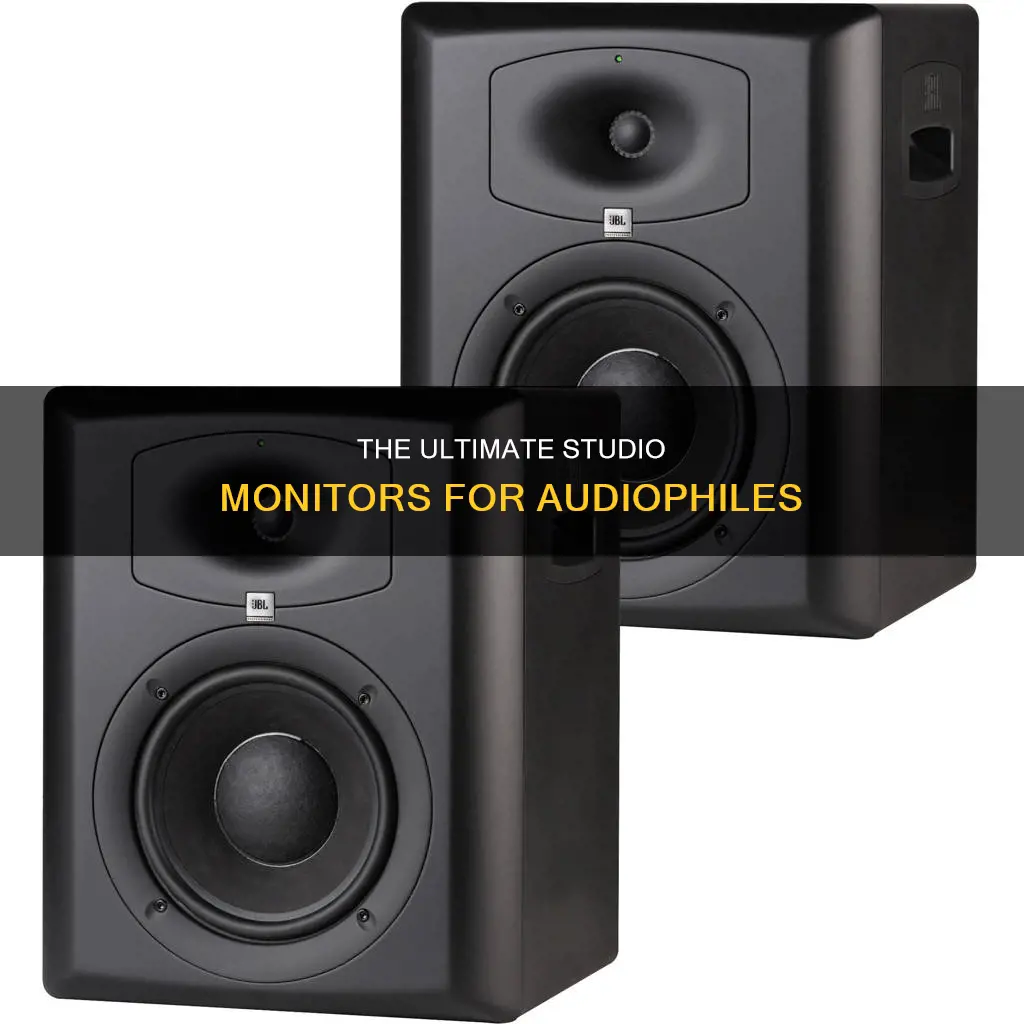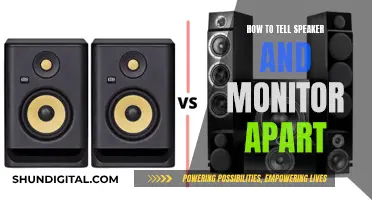
Studio monitors and Hi-Fi speakers may look similar, but they are designed for different purposes and have distinct characteristics. Studio monitors are used in professional audio production to create precise, dynamic sound mixes, allowing users to identify and fix audio issues. They are typically active speakers, meaning they have built-in amplifiers and are powered. On the other hand, Hi-Fi speakers are designed to deliver high-quality sound in any environment and are usually passive, requiring external power from a separate amplifier. Studio monitors are ideal for critical listening and spotting imperfections, while Hi-Fi speakers enhance the listening experience by boosting the top and bottom ends.
| Characteristics | Values |
|---|---|
| Frequency response | 80Hz–22kHz, 45 Hz - 20 kHz, 42 Hz – 40 kHz, 54 Hz – 30 kHz, 49Hz - 20kHz (±3dB), 40 Hz - 35 kHz, 39Hz - 25kHz, 40 Hz to 24 kHz, 60Hz - 20kHz, 56Hz - 20kHz, 35Hz - 20kHz |
| Speaker configuration | 2-way, 2-Way/3-speakers bi-amped |
| Tweeter type | 1” kevlar, Ribbon, Kevlar, Kevlar, Soft dome, Aluminium/magnesium inverted dome, 1” soft dome, 1.5” chambered textile dome, 1" low distortion, back chambered silk dome |
| Inputs | 1x RCA stereo input pair, 2x 1/4" (6.35 mm) TRS inputs, 1x 1/8" (3.5 mm) stereo auxiliary input, Combo input XLR / 6.3mm balanced jack, 1 x XLR, 1 x 1/4" TRS, 1 x RCA, 1x combo XLR-1/4” TRS balanced input; 1/8” TS ARC microphone input, XLR, 1/4" TRS, RCA inputs, Combo XLR / TRS input |
| Digital connectivity | No, None, No, No, No, No, No, 1 x USB type-B (service only), input for omnidirectional, mems based precision measurement microphone |
| Driver size | 4.5”, 5”, 7”, 5”, 6.5", 1.5”, 8”, 5”, 4.5”, 6.5”, 3”, 4”, 5”, 8" |
What You'll Learn

Active vs passive speakers
Studio monitors are designed to have a flat frequency response, meaning all frequencies are played at the same volume level. This is in contrast to regular Hi-Fi speakers, which are often "biased" to emphasise certain frequencies, such as adding more bass or boosting treble to make the music sound crisp and clear. Studio monitors aim to give a true representation of the sound, ensuring accurate mixing and mastering.
Studio monitors are "active" or "powered", meaning they have built-in amplifiers. This is in contrast to Hi-Fi speakers, which are almost always "passive", requiring an external amplifier. Active speakers offer more punch and a more accurate dynamic response, as each speaker (woofer, tweeter, mid-range) has its own amplifier. This also makes it easier to build top-quality crossovers, which can be placed before the power amps, and to obtain steeper filter slopes, reducing overlap between speakers and resulting in a clearer, more detailed sound image.
However, passive speakers give you more flexibility, as you can select and upgrade your amplifier as you please. They also tend to be less expensive upfront, although they may end up costing more in the long run due to the need for separate equipment. Active monitors, on the other hand, are typically more expensive upfront due to the built-in amplifiers, but they are more cost-effective in the long run as no extra equipment is needed. They also simplify cabling and can be more durable, as individual components can be replaced if needed.
So, which type of monitor is right for you? If you want a streamlined setup with fewer cables and components, and a plug-and-play solution that's reliable and accurate, active monitors are the way to go. But if you want more flexibility and are willing to put in a little extra effort, passive monitors might be better, as you can choose an external amplifier to find the perfect match for your monitors.
Kia Stinger: Blind Spot Monitor Availability and Performance
You may want to see also

Studio monitors are for critical listening
Studio monitors are designed for critical listening, allowing users to identify and fix any audio issues or flaws. They are typically used in professional studio environments and are crucial for audio recording, mixing, and mastering. In contrast, Hi-Fi speakers are designed to provide excellent sound quality in any environment and are targeted towards music enthusiasts and consumers who want to enhance their listening experience.
Studio monitors are usually active speakers, meaning they have built-in amplifiers, while Hi-Fi speakers are typically passive and require external power from a separate amplifier. This gives studio monitors an advantage in terms of precision since the built-in amplifier can supply power separately to the woofer and tweeter cones. Additionally, studio monitors have a flat, accurate sound and do not emphasise any particular frequency, allowing for the most accurate sense of a mix. This makes them ideal for identifying flaws and imperfections in the audio.
When choosing studio monitors, it is important to consider speaker specifications, features, and budget. A good studio monitor should provide minimal distortion, comprehensive frequency response, exceptional stereo imaging, high volume, and neutral sound coloration. It should also have a neutral advantage, meaning it is neither too dull nor too bright, to achieve tonal acceptability on a wide range of systems.
Studio monitors are essential for professionals who require accurate and reference-quality sound for recording, mixing, and mastering. They are designed for nearfield use, providing a direct and clear sound to the listener. On the other hand, Hi-Fi speakers are typically considered Farfield, as they are designed to sound good from any direction and in any room.
While studio monitors may not be the best choice for casual music listening in a living room or home theatre setup, they are perfect for critical listening and professional audio work.
Performance Monitors: Myths and Misconceptions
You may want to see also

Hi-Fi speakers are for music lovers
Hi-Fi speakers are typically passive, meaning they require an external power source such as an amplifier to function. They are designed to provide excellent sound quality in any environment and are usually part of a 2.0 sound system, with a right and left channel.
On the other hand, studio monitors are loudspeakers used in professional audio production applications. They are designed for critical listening, allowing users to identify and fix any audio issues or flaws. Studio monitors are typically active speakers, meaning they have built-in power amplifiers, while Hi-Fi speakers are passive and require external amplification.
Studio monitors are crucial for audio recording, mixing, and mastering, as they create precise and dynamic sound mixes. They are often used in bedroom studios or top-class facilities to ensure an accurate representation of the audio being worked on.
While Hi-Fi speakers enhance the listening experience by boosting the top and bottom ends, studio monitors provide a flat and accurate sound, making them ideal for identifying imperfections in the audio. Studio monitors are designed for nearfield use, meaning they are placed close to the listener to provide a direct and clear sound.
In summary, Hi-Fi speakers are for music enthusiasts who want the best sound quality in their homes, while studio monitors are used by professionals for critical listening and audio production tasks.
Monitoring GeForce 1080 Ti: Tracking Performance and Usage
You may want to see also

Studio monitors are for professionals
Studio monitors are designed for professionals in the audio recording, mixing, and mastering industry. They are an essential part of the recording and mixing process and are used to create precise, dynamic sound mixes that are clear, allowing users to spot and fix any audio quality issues. Studio monitors are typically active speakers, meaning they have built-in power amplifiers and are powered by themselves. They are also designed for critical listening, which means they can pick out any sound imperfections and fix them.
Studio monitors are usually found in professional studio environments and are not meant to be used as regular speakers. They are designed to provide a sound that is flat and lacks any character or colour. This means that you will hear a different sound from your regular speakers. Studio monitors are also designed for nearfield use, which means they are meant to be used within a few feet of the listener to provide a clear and direct sound.
Studio monitors have a precise, flat sound for nearfield usage and do not emphasize any particular frequency. This allows users to get an accurate impression of a mix and identify any imperfections. The design of studio monitors also ensures that they have individual power amplifiers for each speaker, which makes the sound more accurate.
When choosing studio monitors, it is important to consider speaker specifications, features, and budget. A good studio monitor should have minimal distortion, comprehensive frequency response, exceptional stereo imaging, high volume, and neutral sound coloration. It should also have a neutral advantage, meaning it should not be too dull or too bright, to achieve tonal acceptability on a wide range of systems.
In summary, studio monitors are designed for professionals who require precise and accurate sound for critical listening and audio production applications. They are an essential tool for anyone looking to create high-quality audio recordings, mixes, or masters.
The Largest Display: Monitor Size Extremes
You may want to see also

Studio monitors are for nearfield use
Studio monitors are designed for near-field use, meaning they are placed a few feet away from the listener. This close proximity means that more direct sound from the monitor will reach the listener's ears, rather than reflected sound from surfaces in the room. This reduces the impact of room acoustics, allowing for more detailed work, such as identifying small problems in the mix like pops and clicks.
Near-field monitors are also beneficial because they tend to have a slightly narrower frequency response, which can be more similar to consumer monitors. Hearing a mix in this environment can be an accurate representation of the average listener's experience.
When it comes to placement, near-field monitors should be positioned on stands or a desk. If placed on a desk, isolation pads can be used to reduce the effect of the desk resonating with the sound. However, stands are generally recommended to minimise the impact of sound waves bouncing off the desk.
The opposite of near-field monitors are far-field monitors, which are designed to fill a room with sound and are typically placed several metres away from the listener.
Performance Monitor: Freeing Up DLLs
You may want to see also
Frequently asked questions
Some good options for studio monitors include the Presonus Eris E44, the JBL LSR305, the KRK Rokit, and the Yamaha HS8.
Studio monitors are typically used in professional audio production applications, such as recording, mixing, and mastering, and are designed for critical listening to identify and fix any audio issues. They are usually active speakers, meaning they have built-in amplifiers, and are designed to produce a flat, accurate sound. On the other hand, Hi-Fi speakers are typically passive speakers, powered by an external amplifier, and are designed to provide good sound quality in any environment, often enhancing the listening experience by boosting the bottom and top ends.
It is not recommended to use Hi-Fi speakers as studio monitors, as they may not provide an accurate representation of your mix. Studio monitors are designed to deliver a reference audio quality that is unaffected and crisp, allowing you to make confident mix decisions.
When choosing a studio monitor, look for minimal distortion, comprehensive frequency response, exceptional stereo imaging, high volume capability, and neutral sound coloration. The studio monitor should have a neutral advantage, meaning it should not be too dull or too bright, to achieve tonal acceptability on a wide range of systems.







